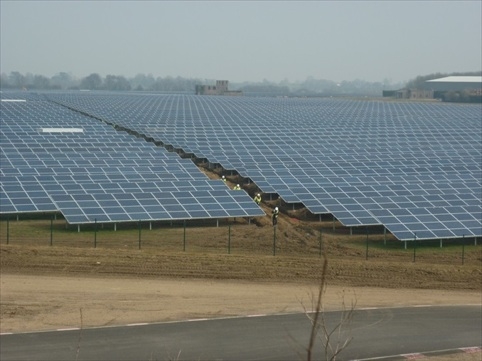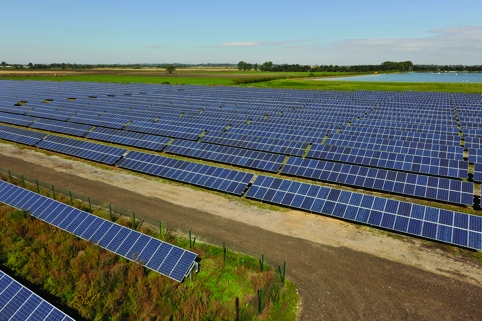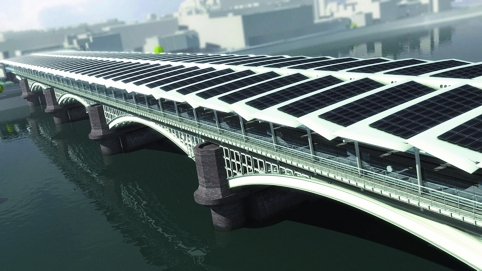In just two years, our solar power-generating capacity has gone from practically zero to around 2.5GW, and with the government targeting 20GW of photovoltaic (PV) generating capacity by 2020, this rapid growth shows little sign of slowing down.
So far, the dramatic explosion of solar has largely been driven by generous subsidies — a major bugbear for renewable-energy sceptics. But many believe the industry is approaching a point where it will soon be able to stand on its own feet.
Around 1.9GW of existing UK capacity is installed on the roofs of buildings — from domestic installations to larger-scale schemes such as the Blackfriars Bridge project (see picture). The rest, around 0.6GW, is in the form of ground-mounted installations, or solar farms, which are currently springing up with astonishing speed across the countryside.
Solar works significantly better in the UK than some of the computer predictions claimRay Noble, National solar centre
Activity is concentrated in the UK’s sunniest regions in the South West, where there are now more than 70 solar farms with a combined capacity of 290MW. According to sustainable-energy specialist Regen SW, these will generate around 250GWh of renewable electricity a year.
But there’s plenty going on elsewhere in the UK. Somerset-based British Solar Renewables, which is developing a number of sites across the UK, recently secured planning permission for a 20MW farm at North Creake airfield in Norfolk. Whilst the UK’s largest solar farm yet — Lark Energy’s 34MW installation at Wymeswold Airfield Loughborough — joined the grid just a few weeks ago.

Less visually intrusive, quicker and cheaper to install, and requiring little maintenance, solar farms have some compelling advantages over wind farms. Plus — while it’s perhaps surprising that a country that is covered in cloud for much of the year should be the site of so much development — the UK’s solar resource is actually pretty significant.
Indeed, according to solar-industry veteran and co-chair of the government’s solar-strategy group Ray Noble, UK solar is consistently outperforming predictions, with investors regularly reporting for higher returns than expected. ‘Solar works significantly better in the UK than some of the computer predictions claim,’ said Noble, ‘it’s something like a 15–20 per cent increase in performance to what was originally expected.’
The UK boom began in 2010 with the introduction of generous feed-in tariffs for both domestic and larger-scale solar installations. Surprised by the ensuing ‘gold rush’, the government quickly scaled back the scheme and many of the companies whose business models depended on the tariff went bust. It was, said Noble ‘a mess’.
Solar panels today are roughly a third of the cost of what they were three years ago. This has transformed the economics for the large-scale solar farm and ROCs have still come out at a level where big developers can still do business.Dr Tim Bruton, solar industry consultant
But the scheme had at least achieved one of its key aims: kick-starting what was effectively a new industry for the UK. And, although the FITs were no longer an option for large-scale developers,the plummeting price of solar modules, now produced in high volumes in the Far East, combined with another subsidy package — the renewable obligation (RO) scheme — made large-scale solar plants an attractive opportunity.
Under the RO scheme, renewable obligation certificates (ROCs) are issued to renewable-energy firms. These can be sold on to other energy firms to allow them to meet their requirement to derive a percentage of their energy form renewables. Initially, solar generators received two ROCs for each MWh of electricity generated. A reduction to 1.6, which came into effect at the end if March this year (2013), prompted another rush and around 500MW of solar parks were installed in a couple of months.

But with plenty of new schemes still in the pipeline, and cuts to subsidies tracking a decline in price of the solar modules, the ROC scheme seems to be working. ‘Solar panels today are roughly a third of the cost of what they were three years ago,’ said solar-industry consultant Dr Tim Bruton, former chief technology officer at NaREC. ‘This transformed the economics for the large-scale solar farm and ROCs have still come out at a level where big developers can still do business.’
The opportunity is feasible and everyone’s now gearing up to get on with this year’s tranche of sites, but their investment models are all slightly different and everything’s more squeezed. It’s going to get tougher, there’s no doubt about it.Tim Rose, Solar Century
Tim Rose, sales director of one of the biggest UK solar firms, Solar Century, has been exposed to the sharp end of these economics. To date, his firm has installed 178MW of solar and over the last 12 months has seen major growth in the solar-farm sector, installing around 80MW across 10–12 different locations.
Rose agreed with the view that the incentives are tracking the market and confirmed that solar-panel prices have dropped by more than half since 2010/2011. But he is concerned that the ROCs are being cut too aggressively. ‘At the end of March the incentive dropped from two to 1.6, so we lost 20 per cent. That still means that the opportunity is feasible and everyone’s now gearing up to get on with this year’s tranche of sites, but their investment models are all slightly different and everything’s more squeezed. It’s going to get tougher, there’s no doubt about it.’
Despite a slightly less frenetic climate, there’s still a sense that the UK solar business is reeling from the shock of its sudden expansion, and last month, in an effort to instil some clear-thinking into an industry awash with confusion, the National Solar Centre (NSC) was launched in St Austell, Cornwall.
‘What we’re aiming to do is correct all the learning curves of an industry that’s grown too quickly,’ said Noble, one of the driving forces behind the NSC. ‘It will provide a resource that can offer anyone wanting to get into solar impartial, consistent and expert advice on how to carry out installations and provide evidence on how well it performs.’
Another area of concern is that the low-cost modules fuelling the current boom carry a hidden cost. Bruton pointed to rumours that some manufacturers in the Far East may be cuttingcorners.‘There’s unease among certain people that the quality of the Chinese product may not be same as the quality of the product that was previously available from European, Japanese and US manufacturers,’ he said.

Part of the problem, he suggested, is that, in order to achieve international certification, a manufacturer need only provide eight modules, and there’s a suspicion that some may be producing eight exceptional modules to gain certification and then cutting corners on the main manufacturing process.
Noble has also heard the rumours and said that one of the aims of the NSC is to provide proper, unbiased comparison of the available technology. ‘We will pick them out of the factories — we don’t want them making special ones that work better — and put them on a big site where they can all be compared. All the tier one manufacturers have said ‘no problem’. This is how we’re going to try to correct what’s been happening in the industry.’
Another concern is that, in the face of all this new generating capacity, the distribution network will be unable to cope. Noble pointed to a growing feeling in the industry, and critically among hi scontacts at DECC, that the UK needs to develop energy storage technology if it’s to really tap into its solar potential.
Such systems, which are already widespread in Germany and Japan, could, he said, be used to store renewable energy generated during the day and re-inject it into the distribution network attimes of peak supply.
He added that the UK’s burgeoning battery expertise, which has sprung up around the fast-growing low-carbon vehicle sector, could help play a role in this. Indeed, Noble believes that the industry offers a number of opportunities for UK engineering firms and pointed to British Solar Renewables’ model of only importing the solar modules and having everything else, including the inverters and support structures, produced in the UK, as the start of a very exciting trend for UK firms.
He even believes that the UK could eventually develop it’s own solar-module manufacturing base. ‘I think what’s going to happen is exactly what happened with Honda, Toyota and Nissan in the UK automotive industry. They built assembly plants which have become manufacturing plants and they’ve ended up exporting back to Japan. Transferring modules around the world is a waste of time because you’ve got a container full of fresh air. Within two to three years I can see assembly being done in Europe and the UK. It’s a super-fast-moving industry. The problem is trying to keep up with it.’




Swiss geoengineering start-up targets methane removal
Several rather dubious statistics in this report. IF methane had 120× the thermal effect of CO2 that would be TWO orders of magnitude. Two is not...